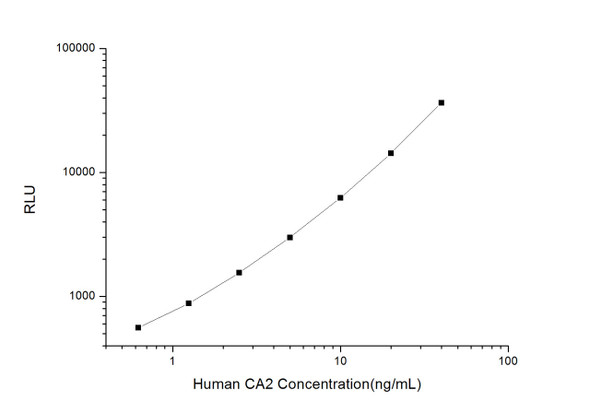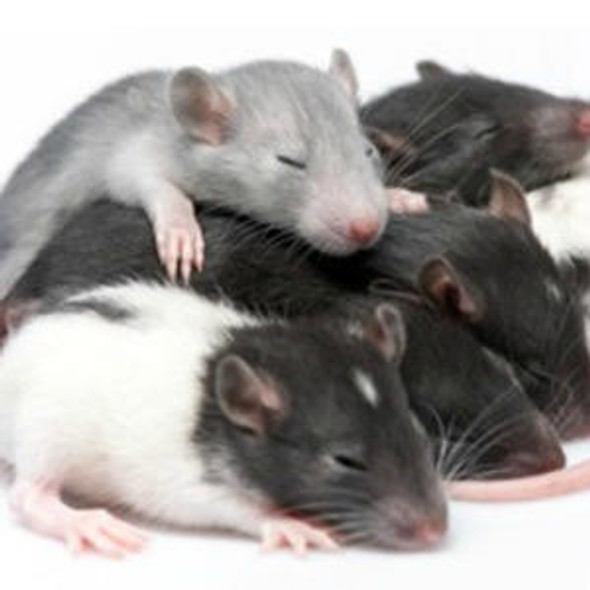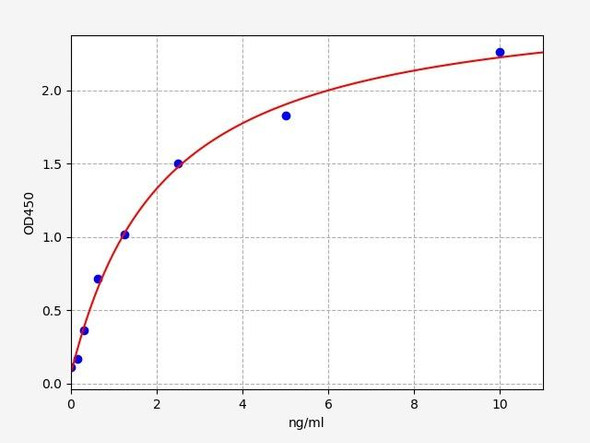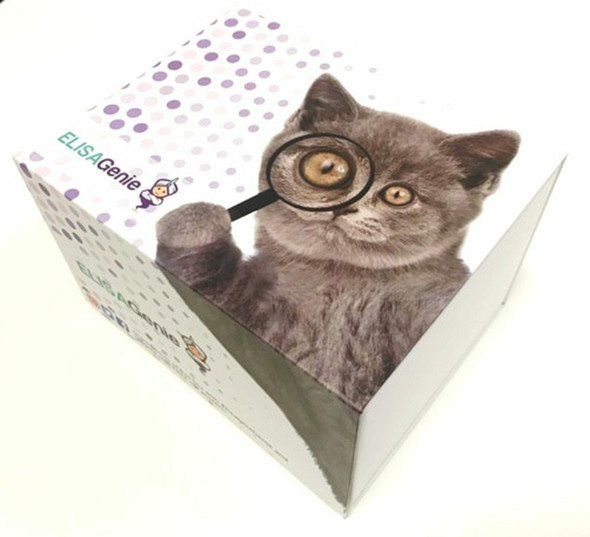Rat Signaling ELISA Kits 2
Rat CA2 (Carbonic Anhydrase II) CLIA Kit (RTES00087)
- SKU:
- RTES00087
- Product Type:
- ELISA Kit
- ELISA Type:
- CLIA Kit
- Size:
- 96 Assays
- Sensitivity:
- 0.28ng/mL
- Range:
- 0.47-30ng/mL
- ELISA Type:
- Sandwich
- Synonyms:
- CA-II, CAII, CAC, Car2
- Reactivity:
- Rat
- Sample Type:
- Serum, plasma and other biological fluids
Description
| Assay type: | Sandwich |
| Format: | 96T |
| Assay time: | 4.5h |
| Reactivity: | Rat |
| Detection method: | Chemiluminescence |
| Detection range: | 0.47-30 ng/mL |
| Sensitivity: | 0.28 ng/mL |
| Sample volume: | 100µL |
| Sample type: | Serum, plasma and other biological fluids |
| Repeatability: | CV < 15% |
| Specificity: | This kit recognizes Rat CA2 in samples. No significant cross-reactivity or interference between Rat CA2 and analogues was observed. |
This kit uses Sandwich-CLIA as the method. The micro CLIA plate provided in this kit has been pre-coated with an antibody specific to Rat CA2. Standards or samples are added to the appropriate micro CLIA plate wells and combined with the specific antibody. Then a biotinylated detection antibody specific for Rat CA2 and Avidin-Horseradish Peroxidase (HRP) conjugate are added to each micro plate well successively and incubated. Free components are washed away. The substrate solution is added to each well. Only those wells that contain Rat CA2, biotinylated detection antibody and Avidin-HRP conjugate will appear fluorescence. The Relative light unit (RLU) value is measured spectrophotometrically by the Chemiluminescence immunoassay analyzer. The RLU value is positively associated with the concentration of Rat CA2. The concentration of Rat CA2 in the samples can be calculated by comparing the RLU of the samples to the standard curve.
| UniProt Protein Function: | CA2: Essential for bone resorption and osteoclast differentiation. Reversible hydration of carbon dioxide. Can hydrates cyanamide to urea. Involved in the regulation of fluid secretion into the anterior chamber of the eye. Interacts with SLC4A4. Interaction with SLC4A7 regulates SLC4A7 transporter activity. Activated by X-ray, histamine, L-adrenaline, L- and D-phenylalanine, L- and D-histidine, L-His-OMe and beta-Ala- His (carnosine). Competitively inhibited by saccharin, thioxolone, coumarins, 667-coumate, celecoxib (Celebrex), valdecoxib (Bextra), SC-125, SC-560, diclofenac, acetate, azide, bromide, sulfonamide derivatives such as acetazolamide (AZA), methazolamide (MZA), ethoxzolamide (EZA), dichlorophenamide (DCP), brinzolamide, dansylamide, thiabendazole-5-sulfonamide, trifluoromethane sulfonamide and N-hydroxysulfamide, fructose-based sugar sulfamate RWJ-37497, and Foscarnet (phosphonoformate trisodium salt). Repressed strongly by hydrogen sulfide(HS) and weakly by nitrate (NO(3)). Esterase activity weakly reduced by cyanamide. N- hydroxyurea interfers with zinc binding and inhibit activity. Belongs to the alpha-carbonic anhydrase family. |
| UniProt Protein Details: | Protein type:Energy Metabolism - nitrogen; EC 4. 2. 1. 1; Lyase Cellular Component: apical part of cell; axon; basolateral plasma membrane; cytoplasm; cytosol; extracellular space; microvillus; myelin sheath; plasma membrane Molecular Function:arylesterase activity; carbonate dehydratase activity; protein binding; zinc ion binding Biological Process: carbon dioxide transport; kidney development; morphogenesis of an epithelium; odontogenesis of dentine-containing teeth; one-carbon compound metabolic process; osteoclast differentiation; positive regulation of bone resorption; positive regulation of cellular pH reduction; positive regulation of osteoclast differentiation; positive regulation of synaptic transmission, GABAergic; regulation of bone resorption; regulation of cellular pH; regulation of intracellular pH; response to estrogen stimulus; response to organic substance; response to pH; response to steroid hormone stimulus; response to zinc ion; secretion |
| NCBI Summary: | putative carbonic anhydrase; human homolog catalyzes the reversible hydration of carbon dioxide [RGD, Feb 2006] |
| UniProt Code: | P27139 |
| NCBI GenInfo Identifier: | 9506445 |
| NCBI Gene ID: | 54231 |
| NCBI Accession: | NP_062164. 1 |
| UniProt Related Accession: | P27139 |
| Molecular Weight: | 29,114 Da |
| NCBI Full Name: | carbonic anhydrase 2 |
| NCBI Synonym Full Names: | carbonic anhydrase 2 |
| NCBI Official Symbol: | Car2 |
| NCBI Official Synonym Symbols: | Ca2 |
| NCBI Protein Information: | carbonic anhydrase 2 |
| UniProt Protein Name: | Carbonic anhydrase 2 |
| UniProt Synonym Protein Names: | Carbonate dehydratase II; Carbonic anhydrase II; CA-II |
| Protein Family: | Carbonic anhydrase |
| UniProt Gene Name: | Ca2 |
| UniProt Entry Name: | CAH2_RAT |
As the RLU values of the standard curve may vary according to the conditions of the actual assay performance (e. g. operator, pipetting technique, washing technique or temperature effects), the operator should establish a standard curve for each test. Typical standard curve and data is provided below for reference only.
| Concentration (ng/mL) | RLU | Average | Corrected |
| 30 | 33045 37973 | 35509 | 35469 |
| 15 | 12684 14310 | 13497 | 13457 |
| 7.5 | 5967 5669 | 5818 | 5778 |
| 3.75 | 2712 2908 | 2810 | 2770 |
| 1.88 | 1578 1450 | 1514 | 1474 |
| 0.94 | 983 853 | 918 | 878 |
| 0.47 | 630 636 | 633 | 593 |
| 0 | 39 41 | 40 | -- |
Precision
Intra-assay Precision (Precision within an assay): 3 samples with low, mid range and high level Rat CA2 were tested 20 times on one plate, respectively.
Inter-assay Precision (Precision between assays): 3 samples with low, mid range and high level Rat CA2 were tested on 3 different plates, 20 replicates in each plate.
| Intra-assay Precision | Inter-assay Precision | |||||
| Sample | 1 | 2 | 3 | 1 | 2 | 3 |
| n | 20 | 20 | 20 | 20 | 20 | 20 |
| Mean (ng/mL) | 1.41 | 3.75 | 13.27 | 1.28 | 3.73 | 14.41 |
| Standard deviation | 0.16 | 0.40 | 0.89 | 0.10 | 0.39 | 1.07 |
| C V (%) | 11.35 | 10.67 | 6.71 | 7.81 | 10.46 | 7.43 |
Recovery
The recovery of Rat CA2 spiked at three different levels in samples throughout the range of the assay was evaluated in various matrices.
| Sample Type | Range (%) | Average Recovery (%) |
| Serum (n=5) | 94-110 | 100 |
| EDTA plasma (n=5) | 99-113 | 105 |
| Cell culture media (n=5) | 100-116 | 107 |
Linearity
Samples were spiked with high concentrations of Rat CA2 and diluted with Reference Standard & Sample Diluent to produce samples with values within the range of the assay.
| Serum (n=5) | EDTA plasma (n=5) | Cell culture media (n=5) | ||
| 1:2 | Range (%) | 99-115 | 89-105 | 100-112 |
| Average (%) | 105 | 96 | 106 | |
| 1:4 | Range (%) | 87-101 | 101-117 | 97-110 |
| Average (%) | 94 | 107 | 104 | |
| 1:8 | Range (%) | 98-114 | 87-100 | 85-96 |
| Average (%) | 104 | 93 | 91 | |
| 1:16 | Range (%) | 90-100 | 97-111 | 98-116 |
| Average (%) | 95 | 104 | 106 |
An unopened kit can be stored at 4°C for 1 month. If the kit is not used within 1 month, store the items separately according to the following conditions once the kit is received.
| Item | Specifications | Storage |
| Micro CLIA Plate(Dismountable) | 8 wells ×12 strips | -20°C, 6 months |
| Reference Standard | 2 vials | |
| Concentrated Biotinylated Detection Ab (100×) | 1 vial, 120 µL | |
| Concentrated HRP Conjugate (100×) | 1 vial, 120 µL | -20°C(shading light), 6 months |
| Reference Standard & Sample Diluent | 1 vial, 20 mL | 4°C, 6 months |
| Biotinylated Detection Ab Diluent | 1 vial, 14 mL | |
| HRP Conjugate Diluent | 1 vial, 14 mL | |
| Concentrated Wash Buffer (25×) | 1 vial, 30 mL | |
| Substrate Reagent A | 1 vial, 5 mL | 4°C (shading light) |
| Substrate Reagent B | 1 vial, 5 mL | 4°C (shading light) |
| Plate Sealer | 5 pieces | |
| Product Description | 1 copy | |
| Certificate of Analysis | 1 copy |
- Set standard, test sample and control (zero) wells on the pre-coated plate and record theirpositions. It is recommended to measure each standard and sample in duplicate. Note: addall solutions to the bottom of the plate wells while avoiding contact with the well walls. Ensuresolutions do not foam when adding to the wells.
- Aliquot 100µl of standard solutions into the standard wells.
- Add 100µl of Sample / Standard dilution buffer into the control (zero) well.
- Add 100µl of properly diluted sample (serum, plasma, tissue homogenates and otherbiological fluids. ) into test sample wells.
- Cover the plate with the sealer provided in the kit and incubate for 90 min at 37°C.
- Aspirate the liquid from each well, do not wash. Immediately add 100µL of BiotinylatedDetection Ab working solution to each well. Cover the plate with a plate seal and gently mix. Incubate for 1 hour at 37°C.
- Aspirate or decant the solution from the plate and add 350µL of wash buffer to each welland incubate for 1-2 minutes at room temperature. Aspirate the solution from each well andclap the plate on absorbent filter paper to dry. Repeat this process 3 times. Note: a microplatewasher can be used in this step and other wash steps.
- Add 100µL of HRP Conjugate working solution to each well. Cover with a plate seal andincubate for 30 min at 37°C.
- Aspirate or decant the solution from each well. Repeat the wash process for five times asconducted in step 7.
- Add 100µL of Substrate mixture solution to each well. Cover with a new plate seal andincubate for no more than 5 min at 37°C. Protect the plate from light.
- Determine the RLU value of each well immediately.






